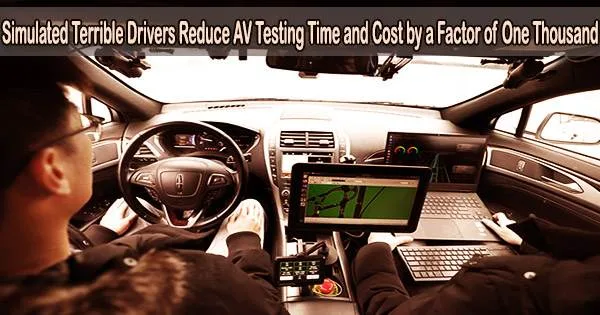The expense and duration of safety testing have been a barrier to the development of totally autonomous vehicles, but a new method created at the University of Michigan demonstrates that artificial intelligence can cut the number of testing miles needed by 99.99%.
It might cause a paradigm change that makes it possible for manufacturers to check more rapidly whether their autonomous vehicle technology can save lives and prevent accidents. Artificial intelligence-powered vehicles practice dangerous maneuvers in a controlled environment, pushing the AV to make choices that are rarely faced by drivers on the road but are necessary to improve the training of the vehicles.
Real-world test vehicles must travel hundreds of millions to hundreds of billions of miles in order to repeatedly experience those kinds of conditions for data collecting.
“The safety critical events the accidents, or the near misses are very rare in the real world, and often time AVs have difficulty handling them,” said Henry Liu, U-M professor of civil engineering and director of both Mcity and the Center for Connected and Automated Transportation, a regional transportation research center funded by the U.S. Department of Transportation.
U-M researchers refer to the problem as the “curse of rarity,” and they’re tackling it by learning from real-world traffic data that contains rare safety-critical events. Testing on dummy test tracks that simulated both urban and highway driving revealed that the AI-trained virtual automobiles could speed up the testing procedure by a factor of thousands. The study is featured on Nature’s cover. The study appears on the cover of Nature.
“The AV test vehicles we’re using are real, but we’ve created a mixed reality testing environment. The background vehicles are virtual, which allows us to train them to create challenging scenarios that only happen rarely on the road,” Liu said.
Dense reinforcement learning will unlock the potential of AI for validating the intelligence of safety-critical autonomous systems such as AVs, medical robotics, and aerospace systems. It also opens the door for accelerated training of safety-critical autonomous systems by leveraging AI-based testing agents, which may create a symbiotic relationship between testing and training, accelerating both fields.
Shuo Feng
The U-M team trained the background automobiles using a method that removes unimportant driving data from the simulation’s driving data. In essence, it eliminates the lengthy periods when other motorists and pedestrians conduct responsibly and as expected but keep the potentially dangerous situations that call for action, such as when a motorist runs a red light.
Test cars can meet more of those uncommon situations in a shorter period of time, making testing far less expensive, by using only safety-critical data to train the neural networks that determine movement decisions.
“Dense reinforcement learning will unlock the potential of AI for validating the intelligence of safety-critical autonomous systems such as AVs, medical robotics, and aerospace systems,” said Shuo Feng, assistant professor in the Department of Automation at Tsinghua University and former assistant research scientist at the U-M Transportation Research Institute.
“It also opens the door for accelerated training of safety-critical autonomous systems by leveraging AI-based testing agents, which may create a symbiotic relationship between testing and training, accelerating both fields.”
And it’s clear that training, along with the time and expense involved, is an impediment. An October Bloomberg article stated that although robotaxi leader Waymo’s vehicles had driven 20 million miles over the previous decade, far more data was needed.
“That means,” the author wrote, “its cars would have to drive an additional 25 times their total before we’d be able to say, with even a vague sense of certainty, that they cause fewer deaths than bus drivers.”
Testing was conducted at Mcity’s urban environment in Ann Arbor, as well as the highway test track at the American Center for Mobility in Ypsilanti.
Launched in 2015, Mcity, was the world’s first purpose-built test environment for connected and autonomous vehicles. Outside researchers will soon be able to conduct remote, mixed-reality tests using both the simulation and actual test track, similar to those described in this paper, thanks to additional funding from the National Science Foundation.
From smart crossings in Ann Arbor and Detroit, as well as future-equipped intersections, real-world data sets are gathered to support Mcity simulations. Every crossroads has sensors installed to protect people’s privacy that record and classify every road user, noting their speed and direction.
The research was funded by the Center for Connected and Automated Transportation and the National Science Foundation.





